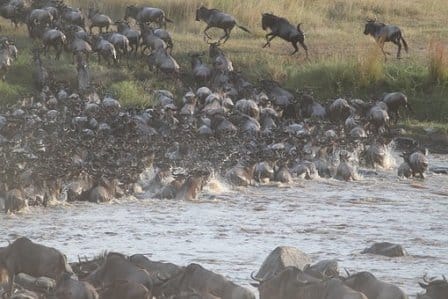The Great wildebeest migration refers to the continuous movement of vast numbers of wildebeest accompanied by large numbers of zebras and gazelles searching for food and water between Tanzania and Kenya.
Wildebeest also known as white bearded Gnu is an antelope with a broad and flattened muzzle, cow like horns, short neck and high shoulders. Males have somewhat thicker and longer horns than females. The Wildebeest is a dominant plains antelope in the acacia savannas of eastern and southern Africa. The broad mouth equips it to graze in short nutritious grasslands. It is built to migrate long distance in search of greener pasture. Wildebeest often graze in mixed herds with zebra, which gives heightened awareness of potential predators. They are also alert to the warning signals emitted by other animals such as baboons.
WHY DO WILDEBEESTE MIGRATE?
Every year, some populations of blue wildebeest in Kenya and Tanzania have a long-distance migration, seemingly timed to coincide with the annual pattern of rainfall and grass growth. Timings of their migrations in both the rainy and dry seasons can vary considerably (by months) from year to year. At the end of the wet season (May or June in East Africa), wildebeest migrate to new areas in response to a lack of surface (drinking) water. When the rainy season begins again (months later), animals quickly move back to their wet-season ranges. Some factors suspected to affect migration include food abundance, surface water availability, predators, and phosphorus content in grasses. Phosphorus is a crucial element for all life forms, particularly for lactating female bovid. As a result, during the rainy season, wildebeest select grazing areas that contain particularly high phosphorus levels.
NON MIGRATING WILDEBEESTE
Not all wildebeest are migratory. Black wildebeest herds may have a regular home range of 1 km2 . Blue wildebeest have both migratory and sedentary populations. In the Ngorongoro Tanzania, most wildebeest are sedentary and males maintain a network of territories throughout the year. For the Serengeti and Tarangire ecosystems also in Tanzania, populations are mostly migratory, with herds consisting of both sexes frequently moving, but resident subpopulations do exist. In the Masai Mara game reserve, a non-migratory population of blue wildebeest also exists. When the migrating wildebeest from Tanzania crosses in to Kenya, the tend to share the same land scape although they are never really absorbed by the migrating group. When the migration crosses back to Tanzania, the Kenyan population remains.
THE MIGRATION
Some times referred to as the Greatest Wildlife Show on Earth or the eighth wonder of the World. But no matter how it is referred to, the annual migration of the wildebeest is one of the most awe-inspiring sights you will ever see.
Around the end of June about 2 million wildebeest accompanied by many zebras and gazelles, will begin their annual migration from the short-grass plains of the Serengeti to the fresh green pastures of the Masai Mara national reserve and its surrounding regions in Kenya. In Mara, they roam for months before heading south into the Serengeti again. While doing so doing, they create one of nature’s greatest spectacles.
Moving in groups the wildebeest thunder across the plateau, drawn by the scent of fresh grass. Arriving at the steep banks of the Mara river, they hurl themselves into its churning waters, and many fall prey to the open jaws of the waiting crocodiles.
Towards the end of October, the herds begin crossing back into Tanzania. The actual timing of the migration is dictated by the weather and and can vary slightly.
Facing multiple dangers such as land predators and crocodiles, the wildebeest complete an 800 km clock wise round trip during the migration.

